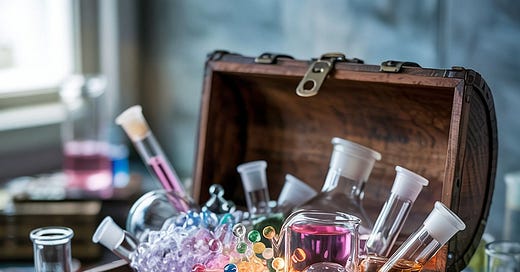Motivated by a suggestion in my previous post, I thought I’d enumerate some of the essential raw materials or perhaps most useful for someone to collect, either for the purpose of learning to formulate or to have a better understanding of the core components of many fragrances on the market. I’m also including materials that are often wrongly described, that consumers really ought to smell for themselves. I go into more detail about this at the bottom of the list.
I have tried to keep the list as minimal as possible and going by olfactory family, though classifications differ. Items marked with an asterisk are those you can omit if truly going for a barebones, absolutely essential only kit.
Green
Cis-3-hexenol (leaf alcohol)
Cis-3-hexenyl acetate*
Styrallyl acetate (Gardenol, 1-phenyl ethyl acetate)
Methyl octyne carbonate (methyl octine carbonate)
Dynascone (Galbascone, Neobutenone alpha) or Galbex base
Galbanum oil*
Phenyl acetaldehyde dimethyl acetal (PADMA, Viridine)
Isobutyl quinoline
Woody
Iso E Super (Sylvamber, Timbersilk, Orbitone T)
Bacdanol (Dartanol, Sandranol, Sanjinol, Sandol)
Polysantol*
Vertofix Coeur
Cashmeran
Ambroxan (Ambrox Super, Ambrofix, Orcanox)
Amber Xtreme
Norlimbanol* (Norlimbanol dextro)
Cedarwood oil (Virginia or Texas)
Vetiver oil (Haiti or Bourbon/Madagascar)
Patchouli oil (Light, Dark, Heart, SFE)
Musky
Galaxolide
Muscenone delta
Helvetolide
Exaltolide* (Macrolide Supra, Pentalide, cyclopentadecanolide)
Habanolide*
Rosy
Phenyl ethyl alcohol
Citronellol
Geraniol
Rose absolute (any origin but not mixed)
Rose oil (any origin but not mixed)
Damascenone beta
Rose oxide (racemic, HC or laevo)
Magnolan
Phenyl ethyl acetate*
Damascone beta*
Damascone alpha*
Geranium oil*
Phenoxanol* (Mefrosol)
Nerol*
Orris/Violet
Ionone beta
Ionone alpha
Methyl ionone gamma (any quality, e.g. pure, coeur)
Methyl ionone alpha extra*
Irone alpha*
White floral
Benzyl acetate
Indole
Jasmine absolute grandiflorum (any origin)
Methyl anthranilate
Cis-jasmone
Oranger crystals
Jasmolactone delta* (other lactones such as jasminlactone and lactone of cis-jasmone are not the same but worth having as extra)
Orange flower absolute*
Spicy
Eugenol
Isoeugenol
Cinnamon bark oil*
Pink pepper oil*
Floral
Linalool
Ethyl linalool*
Hydroxycitronellal
Florol (Florosa)
Cyclamen aldehyde
Hedione (Kharismal, methyl dihydrojasmonate, MDJ)
Terpineol alpha
Hedione HC* (Kharismal Super, MDJ Super)
Citrus
Linalyl acetate
Bergamot oil (FCF, FCR)
Methyl pamplemousse (Amarocit)
Dihydro myrcenol
Ambery
Olibanum oil
Labdanum resinoid or absolute
Cistus oil
Myrrh oil or absolute
Benzoin resinoid
Vanillin
Ethyl vanillin
Vanilla absolute*
Ethyl maltol
Agrestic
Lavender oil France
Clary sage oil
Oakmoss absolute
Coumarin
Aquatic/Marine
Calone 1951 (watermelon ketone)
Helional (Aquanal, Tropional, ocean propanal)
Fruity
Raspberry ketone
Undecalactone gamma (peach aldehyde, peach pure)
Allyl amyl glycolate
Cassis base 345 B
Benzaldehyde
Verdox (OTBCH acetate, green acetate, Agrumex)
Fructone
Paradisamide*
There are constantly reviewers commenting being offended by the use of “ambroxan” which although may be the case, the culprit is usually the far more likely woody amber odorants, rather than ambergris like. Amberketal or Z11 if from Firmenich is known to have a trigeminal effect (that sharp visceral sensation), and is for example used prominently in 1 Million by Paco Rabanne. Amber Xtreme is found everywhere now as well and is incredibly powerful affecting a composition top to bottom. It’s really important people distinguish whether ambroxan truly offends them or it is in fact these woody amber odorants.
Cashmeran is also often compared to cashmere and while there is something nuzzly about it, it is far more woody, pine, earthy with a red fruit facet and warm spice. It is thus incredibly complex and importantly, is not technically a musk though it is musky in its own way and has interesting effects with musks.
I have not mentioned some products here like Heliotropin because they require a license to use in most countries or may be purchasable prediluted. An alternative I can recommend which I know is used in many commercial fragrances is IFF’s Heliotropex N which is a base free of Heliotropin but mimicking it. Similar effects can be achieved with products like anisaldehyde in some cases.
I have included benzaldehyde simply to show how cherry and bitter almond are so interlinked it is why they are almost always mentioned together in note pyramids and how cheap it is to introduce such an effect. Likewise with Verdox for apple though it is more versatile, having woody facets.
I think there is no going back once one smells dihydro myrcenol either. I think no ingredient should ever be demonised but it will be immediately recognised as the defining ingredient to connote masculinity that since Cool Water (despite being used in Drakkar Noir before) has made its way into deodorants, shower gels and the like. It is a very versatile product with effects in trace and finds its way into feminine creations as well, like Coco Mademoiselle.
Myrrh might seem rather niche to include for a starter kit but so many fragrances market myrrh and serve you a standard amber based on labdanum, often in the style of a base like Ambre 83. Real myrrh in the oil or absolute smells mushroomy and slightly liquorice. The resinoid quite different, being drier and spicy without so much of the mushroom and liquorice.
For the financial benefit of those intending to buy materials, I am also listing the materials from the above where you could get away with a gram or two, given that they are very powerful and not needed in large quantities unless intending to compound large batches: cis-3-hexenol, methyl octyne carbonate, isobutyl quinoline, Amber Xtreme, rose oxide, damascenone and damascones, irone alpha, indole, the jasmine lactones, isoeugenol, Calone 1951, raspberry ketone.





Tremendous work, thanks Jamal !
Wonderful, thanks Jamal!